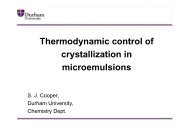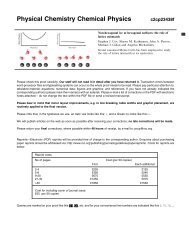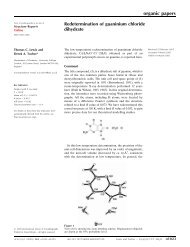ADVANCED USERS DMACRYS & NEIGHCRYS manual Manual ...
ADVANCED USERS DMACRYS & NEIGHCRYS manual Manual ...
ADVANCED USERS DMACRYS & NEIGHCRYS manual Manual ...
Create successful ePaper yourself
Turn your PDF publications into a flip-book with our unique Google optimized e-Paper software.
molecules moving so their centres of mass within RDMA are now included in the higher multipole<br />
calculation. This aspect is a significant improvement on the original method for long molecules and small<br />
RDMA values (e.g. <strong>NEIGHCRYS</strong> default 15 Å).<br />
The spline is also applied to the electrostatic contributions calculated by Ewald summation. Hence the direct<br />
summation is out to the automatically determined direct summation limit + DSPL2, and differs from the true<br />
value by the difference between the true and spline values over the additional DSPL2 range. The cutoff<br />
value for the reciprocal lattice sum and the value of ETA are automatically adjusted to match the actual<br />
direct summation limit including DSPL2. The default accuracy of the Ewald summations means that the<br />
change in the Ewald summed terms is much smaller than the other terms.<br />
Currently <strong>NEIGHCRYS</strong>2.0.8 automatically adds the SPLI command.<br />
Printed output<br />
Potentials will be cutoff with a spline terminating at<br />
with limit in expansion set to splmax Angstroms<br />
splmin Angstroms<br />
Cut off value for direct lattice sum = CUTLAT lattice units<br />
Cut off value for reciprocal lattice sum = CUTRLT reciprocal lattice units<br />
Values of the constants used in these summations are:<br />
Eta parameter for division of sum between real and reciprocal lattice= HFCT0<br />
PI/(ETA^2 * Vol.Cell) = GFCT0<br />
Example output<br />
Potentials will be cutoff with a spline terminating at 2.00Angstroms<br />
with limit in expansion set to 4.00 Angstroms<br />
Cut off value for direct lattice sum = 1.901533 lattice units<br />
Cut off value for reciprocal lattice sum = 2.312667 reciprocal lattice units<br />
Values of the constants used in these summations are:<br />
Eta parameter for division of sum between real and reciprocal lattice= 1.954697<br />
PI/(ETA^2 * Vol.Cell) = 0.402803<br />
This change in the Ewald summation parameters is written out after the original data without a spline.<br />
3.6 POTENTIAL INPUT (other than multipoles & polarizabilities)<br />
3.6.1 REPULSION-DISPERSION POTENTIAL INPUT<br />
Operands<br />
None<br />
POTE<br />
This directive instructs the program to call the repulsion-dispersion potential input routine. This routine is<br />
menu driven with a menu of sub-directives. The sub-directives fall into seven classes: species data, repulsion<br />
& dispersion interactions, [core-shell interactions, three-body interactions, torsion interactions, restart subdirectives]<br />
and subroutine termination. Those in [] are not relevant to this version of <strong>DMACRYS</strong> but are<br />
retained for future use. Table 3.3 gives the sub-directives in each class.<br />
Table 3.3: DIRECTIVES FOR THE POTENTIAL INPUT SUBROUTINE<br />
Directive class<br />
Species data<br />
Repulsion-dispersion interactions<br />
Three-body interactions<br />
Four-body interactions<br />
The full list of potentials available is given in Appendix C.<br />
Directives<br />
SPEC, ENDS<br />
BUCK, MODI, LENN, MORS, BUC4, SPLP,<br />
MORQ, SPRI, COUL, VDWA, HULB, BUC7,<br />
NONE, BSPL,DBUC<br />
BOHA, TRID, MOLD, QART, SIXT, BOHZ,<br />
THRH, RRHA<br />
TOHA<br />
14







